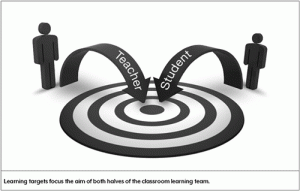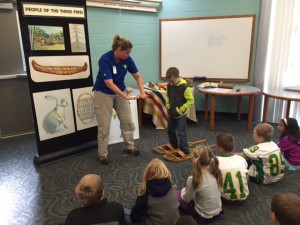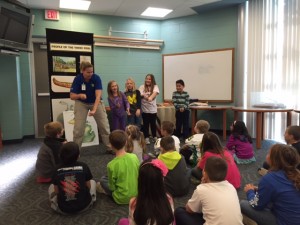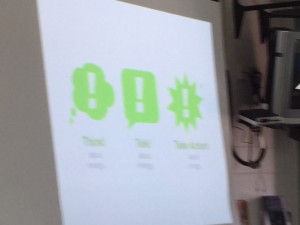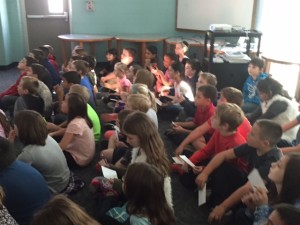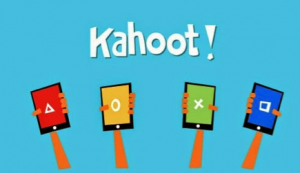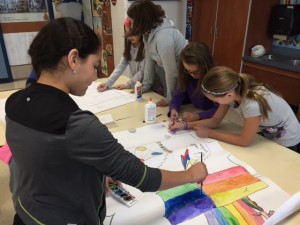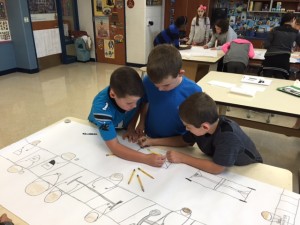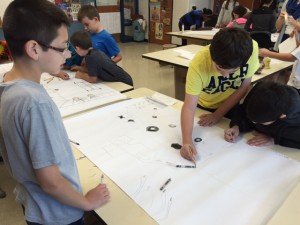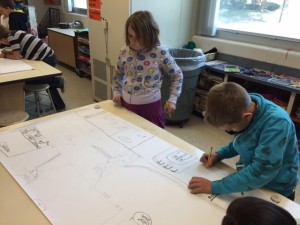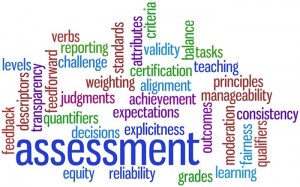Here’s what’s coming up…
October 26 Nothing Scheduled
October 27 Schultz Obs 12:15 and SIP Meeting 3:45
October 28 Math Pilot Info Meeting- All day and PBIS Bingo 9:30
October 29 Principal’s meeting 9:00 and Fall Art and Music Show 5:30
October 30 K Fall Celebration in Cafe 2:00 and Halloween Parade 1:30
 Book Fair
Book Fair
It’s book fair time soon! Please read the attached letter, which is also going out to parents, regarding our book fair dates and info. We will have specific info and schedule sign ups soon.
Attendance
Please give your best effort to meet the agreed upon attendance time deadlines during the school day. In the a.m., make sure your attendance is done no later than 10:00, in the p.m. attendance should be in no later than 2:00. Best thing- take it first before you move on to the next if possible. Thanks for your help on this.
M-STEP
Michigan students set baseline for new state assessment
2014-2015 M-STEP results available soon
October 22, 2015
LANSING – Michigan students have set the course for success when they took the Michigan Student Test of Educational Progress (M-STEP) this past spring, establishing a new baseline for performance, with statewide results available in the days ahead, the Michigan Department of Education (MDE) announced today.
“I’m thrilled that Michigan was a leading state in successfully implementing a new assessment system,” State Superintendent Brian Whiston said. “In 2010, we raised the bar on our state standards and our test now reflects that rigor.”
“This was an all-new and more rigorous test and the statewide results will be lower than we’ve seen in the past, and that’s ok,” Whiston said. “M-STEP sets up a new baseline from which to improve and set us on our way to be a Top Ten education state in 10 years.”
Sandy K. Baruah, President and CEO of the Detroit Regional Chamber, expressed the importance of raising the academic bar for Michigan students.
“As a state, we will not be able to compete in the flat, global 21st Century dynamic marketplace if we don’t have, and achieve, the highest academic standards,” Baruah said. “The discussion should not be maintaining high standards, but rather how can we raise our standards.”
After 44 years of the Michigan Education Assessment Program (MEAP) test, 82 percent of Michigan students across the state sat down in front of computers to take the first-ever M-STEP. A paper and pencil option also was available for buildings not yet prepared to test online.
Whiston said the M-STEP measures the state’s standards that give students a deeper understanding to what they are learning. The standards now take students from just knowing the facts, to learning how to use those facts to understand context, apply them to problem solve, and make those facts relevant in their lives.
In Spring 2016, Michigan students will take the M-STEP in grades 3-8. Students in grade 11 will take the Michigan Merit Exam, which includes the SAT, WorkKeys, and M-STEP science and social studies tests. New for Spring 2016, students in grades 9 and 10 will take the PSAT.
MDE’s Deputy Superintendent of Accountability Services, Venessa Keesler, said that the 2016 M-STEP also will include improvements, based upon the first implementation feedback of school districts and a survey of more than 26,000 students and 5,000 parents to get their initial reaction.
“MDE heard that the testing time was an issue for schools in this first implementation,” Keesler said. “For Spring 2016, MDE is able to reduce testing time for juniors taking the Michigan Merit Exam by eight hours and by two and a half hours for grades three, four, six, and seven.”
The test also can be administered in smaller portions over multiple days so that students will not be required to complete the test all in one sitting, according to Keesler.
Michigan’s federal ESEA Flexibility waiver, approved by the U.S. Department of Education on August 13, 2015, provides that Michigan will not complete or issue public, high-stakes accountability in the form of top-to-bottom rankings and school report cards until Fall 2017. However, MDE will calculate and publish accountability in the form of informational school rankings and diagnostic scorecards in Fall 2016, according to Keesler.
Additionally, MDE will provide schools with useful reports and data that can be used to guide and improve student instruction based upon the first year of implementation of the M-STEP. MDE provided preliminary reports to schools within about two weeks of the close of each testing window.
Whiston said that the department currently is conducting an assessment vision workgroup with education stakeholders to see how student assessments can be streamlined for spring 2017 and beyond.
The M-STEP results will be released in a staggered sequence with the public release of statewide aggregates first in the days ahead. Schools and districts then will receive testing data through the department’s secure website. Later this year, school and district aggregates will be available on mischooldata.org.
For more information, please visit www.michigan.gov/mstep.
What Does It Mean to Share Learning Targets and Criteria for Success?
Sharing learning targets does not mean merely writing the objective on the board or telling students what the objective is in a sentence or two. Most students will, of course, be able to repeat back to the teacher what she said the objective was, and that can be somewhat useful. What we mean by sharing learning targets and criteria for success, however, is that students comprehend what those objectives mean. For example, a reading objective might be that students can identify the main idea in passages of a certain type and level. What we want is more than students being able to say “identify main idea.” We want students to understand that they will learn how to get a better grasp on the meaning of what they read, why that should be a goal for them, and what it feels like to do that. For the student, this means both understanding the learning goal and knowing what good work on the assignment looks like. It’s not a goal if the student can’t envision it.
The single most important method for routinely sharing learning targets is using assignments that match—really match—the learning goal. It is in the assignment that the teacher translates the learning goal into action for the student. The student will strive to do the assignment, not the abstract goal. When we say an assignment or activity must “embody” the learning goal, we mean that the assignment or activity is such a close match with the goal that the student would be able to think, “If I can do [this assignment], then I can do [the learning objective].”
Teachers should always share their goals for students’ learning—both by telling or writing the goals and by giving assignments and activities that embody them—and then check for students’ understanding. It is not enough to ask students, “Do you understand?” They’ll say yes, of course! Rather, teachers should use strategies that help assess students’ comprehension of the meaning of learning goals and their comprehension of what good work looks like. Teachers should use this information to affirm understanding and clarify misconceptions.
Growth Mindset
We had touched upon the growth mindset in a previous blog. Please read the article from Carol Dweck discussing fixed vs growth mindset and think of what types of things you could do in your classroom to start this mindset change.
Carol Dweck Revisits the ‘Growth Mindset’

Let’s look at what happens when teachers, or parents, claim a growth mindset, but don’t follow through. In recent research, Kathy Liu Sun found that there were many math teachers who endorsed a growth mindset and even said the words “growth mindset” in their middle school math classes, but did not follow through in their classroom practices. In these cases, their students tended to endorse more of a fixed mindset about their math ability. My advisee and research collaborator Kyla Haimovitz and I are finding many parents who endorse a growth mindset, but react to their children’s mistakes as though they are problematic or harmful, rather than helpful. In these cases, their children develop more of a fixed mindset about their intelligence.
How can we help educators adopt a deeper, true growth mindset, one that will show in their classroom practices? You may be surprised by my answer: Let’s legitimize the fixed mindset. Let’s acknowledge that (1) we’re all a mixture of fixed and growth mindsets, (2) we will probably always be, and (3) if we want to move closer to a growth mindset in our thoughts and practices, we need to stay in touch with our fixed-mindset thoughts and deeds.
If we “ban” the fixed mindset, we will surely create false growth-mindsets. (By the way, I also fear that if we use mindset measures for accountability, we will create false growth mindsets on an unprecedented scale.) But if we watch carefully for our fixed-mindset triggers, we can begin the true journey to a growth mindset.
What are your triggers?
Watch for a fixed-mindset reaction when you face challenges. Do you feel overly anxious, or does a voice in your head warn you away? Watch for it when you face a setback in your teaching, or when students aren’t listening or learning. Do you feel incompetent or defeated? Do you look for an excuse? Watch to see whether criticism brings out your fixed mindset. Do you become defensive, angry, or crushed instead of interested in learning from the feedback? Watch what happens when you see an educator who’s better than you at something you value. Do you feel envious and threatened, or do you feel eager to learn? Accept those thoughts and feelings and work with and through them. And keep working with and through them.
My colleagues and I are taking a growth-mindset stance toward our message to educators. Maybe we originally put too much emphasis on sheer effort. Maybe we made the development of a growth mindset sound too easy. Maybe we talked too much about people having one mindset or the other, rather than portraying people as mixtures. We are on a growth-mindset journey, too.

Three Fires and 3rd Graders
The third graders participated in a presentation by the Huron-Clinton Metroparks Mobile Learning Center. The program, “The Three Fires,” explored the lives of the Ojibway, Odawa, and Potawatomi Native American tribes in Michigan. The children learned about the tools, shelter, language, and survival strategies through artifacts, replicas and demonstrations. Hands-on learning included fire-making and pump drilling.
DTE Presentation with our 4th graders
DTE Energy THINK! ENERGY
Arno fourth grade students had a great DTE Energy presentation this week called THINK! ENERGY TAKE ACTION! This was a 60 minute interactive, hands-on presentation with a take home energy efficiency kit for each participating student. The program taught our students the importance of energy, natural resources and environmental resources, and gave each participating student’s family energy-efficient technologies to install at home.
Halloween
Our initial weather reports look like we should be able to get outside for the route, which would be great. If its good out, I will be starting at 1:30 with K, and walking my way through the building. You may bring your class out into the hallway to watch and join in as we pass. We will exit through the 5th grade doors, make our way along the fenceline in the interior part of the playground, and wind our way to the front doors to drop off. Indoor would be through the cafe and gym, hopefully we won’t go there.
Please be sure that costumes are appropriate, I have asked for no masks in the blog.
SIP
Please consider coming to our SIP meeting this week Tuesday at 3:45. We will be talking about school improvement initiatives this year, and introducing the notion to form a building data team. I have compiled all goals, strategies, and activities on one front/back page to summarize what everyone agreed to in the plan, which should be too different from the past. I’ll gt that to you next week.
Data Day
I have scheduled our first data day for December first. There will be floaters in the building so that the full grade level may attend that day. I will publish a list of data to bring, but you certainly can supplement. The schedule is as follows:
8:45-9:30 3rd grade
9:35-10:20 5th grade
10:25-11:10 2nd grade
11:15-11:55 4th grade
1:00-1:45 1st grade
1:50-2:30 K
FIRE DRILL
Exit routes have been established for years and have not changed over time. Each year our student population continues to grow. If you feel we need to re-look at exit plan please let me know. I noticed that many of our classes were jammed up in the halls waiting for others to exit safely. If you think a change could be made to make the process smoother, please let me know. Also, please remember all class doors must be closed. The doors are fire rated and the first line of defense to prevent a fire from spreading to other parts of the building. You should always carry your student roster with you to do a complete count once you are out to your post. This concludes all of our drills for the fall.
Who’s KAHOOT’n??
A fun new way to assess your students. Check it out!
Thanks Nicole
Thank you Nicole for organizing another Walk/Ride to School Day. It’s great to see how our Run club continues this mindset for students that it’s a great idea to get up and get moving!
Art and Music Show
Next week Thursday be sure to stop by the Art and Music show at the Performing Arts Center. I was very excited to see a sneak preview of what will be appearing there next week!
NWEA
Fall testing for the NWEA is finally complete. Thank you to all of our teachers for braving this first round with the chromebooks, I couldn’t be happier with how smooth it went and this is a good practice run for m-stepping in the spring. I have set aside the time on Dec. 1 for our data day to review and discuss what is Arno’s current reality. In the meantime, if you feel your grade level needs to have some additional time to break the data down into instructional implications, interventions, and grouping, let me know and I’ll see how we can get more creative with time.
Six Ways MAP Data Can Help Students and Teachers
 Measures of Academic Progress® (MAP®) are K – 12 interim assessments that measure growth, project proficiency on state accountability tests, and inform how educators differentiate instruction, evaluate programs, and structure curriculum. Computer adaptive MAP assessments reveal precisely which academic skills and concepts the student has acquired and what they’re ready to learn. MAP assessments are grade independent and adapt to each student’s instructional level.
Measures of Academic Progress® (MAP®) are K – 12 interim assessments that measure growth, project proficiency on state accountability tests, and inform how educators differentiate instruction, evaluate programs, and structure curriculum. Computer adaptive MAP assessments reveal precisely which academic skills and concepts the student has acquired and what they’re ready to learn. MAP assessments are grade independent and adapt to each student’s instructional level.
MAP data is powerful and can be put to great use to improve instruction and student learning. Here are six ways MAP data can help students and teachers alike:
- Compare and predict student achievement. Using exclusive normative and growth information MAP assessment data can be accurately used to compare and predict student achievement.
- As a universal screener/RTI placement. MAP assessments adapt beyond grade level to find the true level of a student’s performance, helping educators identify at-risk students and build a learning plan. MAP assessments received the highest possible rating for classification accuracy, and high ratings in all other categories, from the National Center on Response to Intervention (NCRTI).
- For differentiated instruction. Students within the same grade often perform at different grade levels, and educators face the challenge of ensuring that every child—from highest to lowest achievers—continues to grow. MAP data make it easy to identify learning levels so teachers can engage in differentiated instruction and skill-based grouping that leads to positive results for every child.
- For student goal setting. Students become more committed to the learning process when they can set goals and see results. Using the Student Goal Setting worksheet and other MAP tools, it’s easy for teachers and students to build an action plan together, and for parents to become engaged in the process.
- To predict proficiency. MAP provides information on where students are performing on individual state and Common Core standards, so test results can be used to project proficiency on high-stakes tests. MAP includes technology-enhanced item types and features that allow for deep assessment of reading, language usage, and mathematics comprehension, and increased cognitive complexity, or Depth of Knowledge, enabling students to demonstrate evidence of their learning.
- For parent communication. MAP helps parents see where students are starting from, and track their growth over time.
Teachers depend on MAP data to help them streamline teaching strategies and provide differentiated instruction, and to create flexible grouping across the classroom. School and district leaders use MAP data to evaluate programs and monitor school and student performance relative to growth, proficiency, and norms. District decision makers rely on MAP data to aid in resource management, help determine performance trends by grade and school, and compare local student achievement to the national scale. MAP data can help all of these stakeholders make the tough decisions necessary to improve student learning.
– See more at: https://www.nwea.org/blog/2015/six-ways-map-data-can-help-students-and-teachers/#sthash.CEXEVDRL.dpuf


